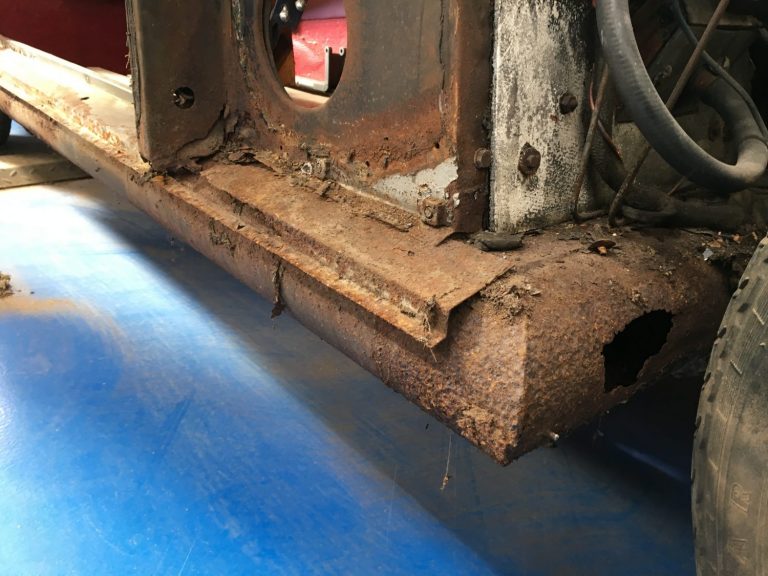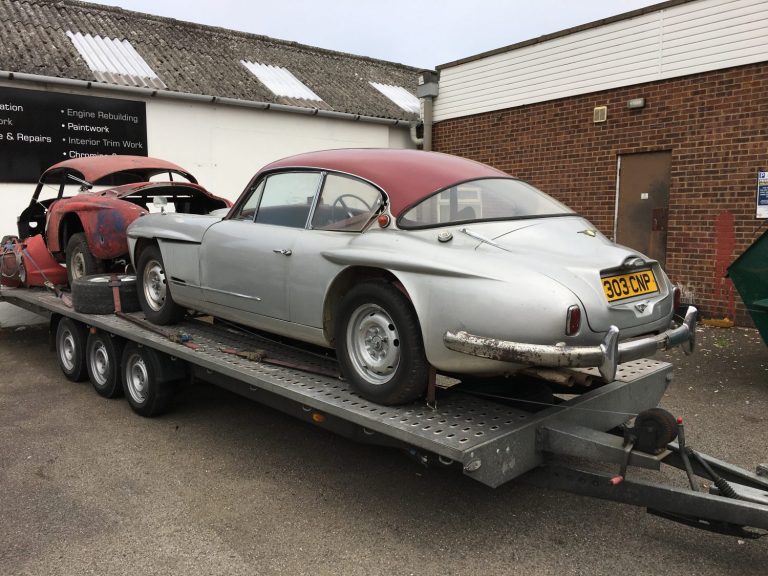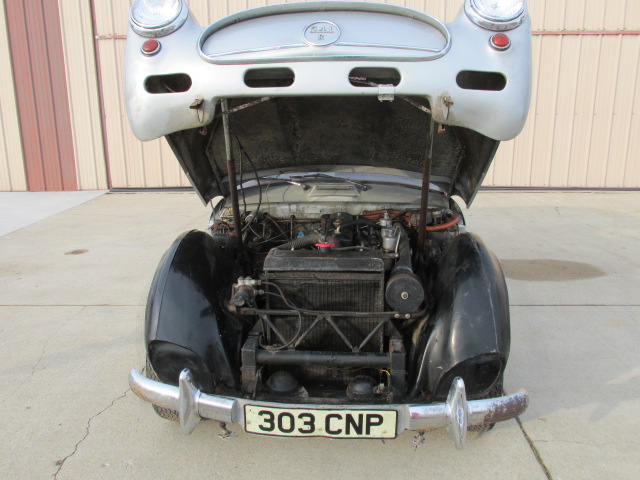
Exposing the Jensen’s chassis
Work has now commenced on our Jensen 541R restorations. First up we have our 1960 Jensen. As with a lot of the Jensen 541’s, we


Work has now commenced on our Jensen 541R restorations. First up we have our 1960 Jensen. As with a lot of the Jensen 541’s, we

Leaving Germany yesterday was our latest ‘soon to arrive’ additon to the Bridge Classic Cars restoration family, a 1960 Jensen 541R. It is the last

[vc_row][vc_column][vc_column_text]The very last Jensen 541R that was built by Jensen Motors (#493), this incredible find is a potential restoration for the future. Currently residing in
Work has now commenced on our Jensen 541R restorations. First up we have our 1960 Jensen.
As with a lot of the Jensen 541’s, we expected to find a lot of work required on the chassis but in order to truly investigate to what extent the body would need to come off.
With this build we are very fortunate to have sourced a fantastic chassis from another project so essentially we are looking to build one car out of two projects.
Leaving Germany yesterday was our latest ‘soon to arrive’ additon to the Bridge Classic Cars restoration family, a 1960 Jensen 541R.
It is the last 541R that to be built by Jensen Motors (#493) and is in need of a little TLC.
Upon arrival to the office this morning we were all greeted by one very large trailer (and a sleeping driver! He had arrive with us at 3am this morning)
[vc_row][vc_column][vc_column_text]The very last Jensen 541R that was built by Jensen Motors (#493), this incredible find is a potential restoration for the future. Currently residing in Germany we are in talks to have her in our workshops later in the year.[/vc_column_text][/vc_column][/vc_row][vc_row][vc_column][vc_gallery type=”image_grid” images=”19684,19685,19686,19687,19688,19689,19690,19691,19692,19693,19694,19695,19696,19697,19698,19699,19700,19701,19702,19703,19704,19705,19706,19707,19708,19709,19710,19711,19681″][/vc_column][/vc_row][vc_row][vc_column][vc_column_text]Source: Wikipedia
The Jensen 541R is a closed four-seater GT-class car built in the United Kingdom by Jensen between 1957 and 1960.
The original aluminium prototype appeared in 1953 as the 541 at the London Motor Show, although this changed to glassfibre for all production cars. Within a year, the new 541 had already earned rave reviews from magazines, notably Autocar, whose testers drove the grand tourer to a top speed of over 125 mph (201 km/h). It was the fastest four-seater the magazine had ever tested at the time.
The 541R employed a low-revving 3,993 cc (4.0 L; 243.7 cu in) straight-six engine from the Austin Sheerline. The suspension system came from the Austin A70 with independent suspension by coil springs at the front and a live axle with semi-elliptic springs at the rear. The 541R, introduced in 1957, differed from the 541 by using rack & pinion steering instead of a cam-and-roller system, and large disc brakes were used on all four wheels.
The car’s styling was by Jensen’s designer Eric Neale, and was not only considered attractive, but was aerodynamically efficient too; a Cd figure of only 0.39 was recorded, which became the lowest figure at Jensen. The body covered a chassis built by bracing 5-inch (12.7 cm) tubes with a mixture of steel pressings and cross-members to create a platform.
The 1957 model carried the DS7 version of the Austin Sheerline’s four-litre motor equipped with twin carburetors on its right side. The cylinder head was reworked for the lifted compression ratio of 7.6:1 and a “long dwell”. The engine had a raised output to 150 hp (112 kW) at 4100 rpm and 210 lb⋅ft (285 N⋅m). Only 53 cars were built with the engine.
In total Jensen built 193 541Rs before it was succeeded in 1961 by the Jensen 541S. This was similar to the 541R, but with a larger body and a GM-licensed Rolls-Royce hydramatic gearbox, and only 127 cars were built before the model was discontinued to be replaced by the CV8.
Performance
Jensen 541R
When the Jensen 541R was tested by Autocar magazine in January 1958 it achieved their highest maximum speed for a four-seater car at 127.5 mph (205.2 km/h). It was conducted in below-freezing conditions with a “stiff diagonal breeze”. 0–60 mph was recorded at 10.6 seconds with fuel consumption at 18 mpg‑imp (16 L/100 km; 15 mpg‑US) overall with the normal range given as 15 mpg‑imp (19 L/100 km; 12 mpg‑US)–24 mpg‑imp(12 L/100 km; 20 mpg‑US).[/vc_column_text][/vc_column][/vc_row]
Bridge Classic Cars are award winning Classic Car Restoration and Maintenance specialists. Your pride and joy is in safe hands with our expert Classic Car Technicians. Take a look at our awards here.
We use cookies to deliver the best possible experience whilst visiting our website. By clicking "Accept All", you consent to our use of cookies, or you can manage your preferences by clicking the link below. You can manage your preferences at any time from out Cookie Policy page.